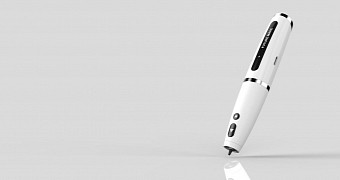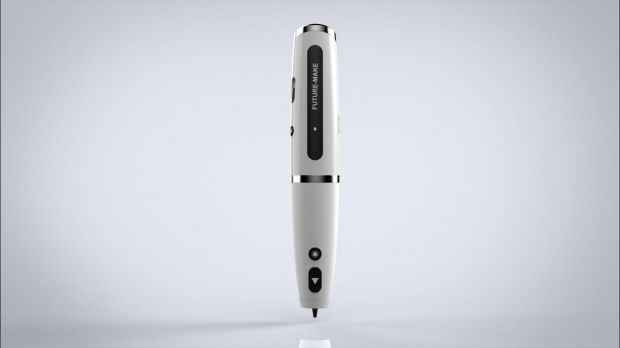Additive manufacturing is the general term for 3D printing technology, but it isn't, technically, totally accurate, since some technologies don't “add” anything while they build the process. Stereolithography is a borderline example, but a new project shows that even it can be made to totally fit the definition.
Additive manufacturing is a term that best describes FDM (fused deposition modeling), where an extruder deposits plastic, or some other material, drop by drop.
Laser sintering and SLA (stereolithography), however, only manipulate what is already there. The former melts powder, the latter cures resin, forcing it to harden. In both cases, the material just sits and waits on a tray or in a tank.
SLA, though, can be adapted under the right circumstances, like when a 3D printer is shaped like a pen.
The Polyes Q1 from Future Make Technology LLC.
The Polyes Q1 is a 3D printing pen that ejects liquid resin from the tip (extruder) and uses light-based SLA to cure it as it comes out. This lets you draw and build things in 3D.
As far as we know, this is the fourth 3D printing pen made so far. The first one, called 3Doodler, debuted in February 2013, but was eventually followed by the Lix and, later, the CreoPop pen. The last in that list is the only one that uses SLA technology.
So we can't exactly say that the Polyes Q1 is all that unique compared to the others. Still, it's impressive because SLA naturally enables a higher level of detail and lets you produce smoother objects too.
SLA is also safer than FDM, since it doesn't produce any fumes (not at this scale anyhow) and doesn't rely on a superheated tip.
Unfortunately, if you're hoping for the pen to be as thin and light as the Lix, you're in for a little disappointment. While the outer design is elegant enough (and we definitely like the all-around white theme), the pen is, nonetheless, pretty fat.
Availability and pricing
Sadly, Future Make Technology has not set a price for the product yet. And with the Kickstarter crowd-funding campaign still being prepared, we can't find the information through that channel either.
Hopefully, it won't be too high. Maybe half-way between $50 / €40 and $100 / €70. Not that the cost of the pen itself will matter that much in the long run, it's the resin supply that will be a constant trickle on your money.
Then again, that's normal for 3D printing technology, so it's not really a disadvantage if you look at it through that prism.

 14 DAY TRIAL //
14 DAY TRIAL // 

